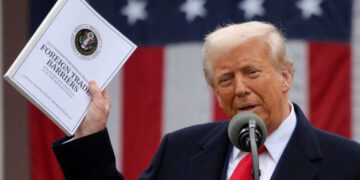By John F. Di Leo -
In a market economy, when there is a public need, the private sector will attempt to meet it. That’s the beauty of the profit motive, after all: it’s an incentive to produce.
If people want food prepared for them, other people open restaurants. If people want to purchase clothing, other people open factories to make it and stores to sell it. If people want to live in a house, then architects and construction companies will build houses (and condos and mansions too) to sell to them.
And, by the same token, if people want a cure for a disease, businesses will arise to meet that need as well.
Now, sometimes, they can’t find a total cure right away… or even ever. There are a lot of illnesses out there that still aren’t really curable.
But it’s amazing how many things the medical/pharmaceutical sciences can do to alleviate symptoms, to lessen severity, to help mitigate the effects of even a permanent illness to a point where it becomes a livable condition.
There are tons of cancers, for example, and the healthcare world has found all sorts of approaches to the challenge. Surgery, medicines, radiation therapy, diet… there is no end to the solutions that have been designed in labs, built in factories, and taught in classrooms. There are advances every day.
From microsurgery using laser tools to amazing little pills, the research and development teams of the world’s healthcare industry kick into high gear as soon as they see a need, and they can often go into production at lightning speed.
There are regulatory holdups, of course, and for good reason, as months or years of clinical trials are usually needed to determine safety, efficacy, and side effects, before such new products can be offered for sale. But these regulatory holdups can be lessened or even waived when appropriate; it’s just a matter of evaluating the relative risks of an untreated illness on one hand, or an unproven potential cure on the other. With calm and fair evaluations, the line can drawn sensibly.
Because of this wonderful system, countless maladies of the past are either curable or at least treatable today.
The CCP Virus
When the CCP Virus (also known as COVID-19 or the Wuhan Flu) first surfaced, this system kicked into action. Researchers all over the world started studying it formally around the clock, and physicians in the field started trying anything they could think of, in their efforts to save its victims.
They have a great deal of information to draw on. For example:
- Years of published studies on similar novel coronaviruses in the lab,
- Maps showing the areas where these viruses are most dangerous and where they aren’t, cross-referenced with other known facts like climate, diet, vaccinations and commonly prescribed drugs in the area.
- Their own knowledge of the symptoms, and ways that such symptoms are usually treated.
- Any known details about this current virus in particular and its origins, since there are certain known challenges that are very specific to the bat-related viruses that they are known to study at the Wuhan Institute of Virology where this one originated.
In just the few months since the appearance of this virus on the world scene, the healthcare world has identified promising directions such as using convalescent plasma or repurposing existing drugs, like the combination of Chloroquine and Zithromax, or Remsdesiver, or the Bacille-Calmette-Guerin (BCG) vaccine.
But drugs aren’t enough, at least not at first. We are going through products like disposable masks, tubes, and gloves by the millions every day. All over the world, the need for such products – from the complex to the simple, has increased geometrically in a matter of weeks.
The Manufacturing World
Treatment for an epidemic requires an infrastructure of massive technology – the pharmaceutical production to quickly make millions of doses of these drugs, the factories to produce complex equipment, from ventilators, computers and monitors to simple materials like those masks, tubes and gloves, and a distribution network of warehouses and transportation carriers to deliver them from factory to user.
In an epidemic, news reports focus on the labs where scientists do their research, and on the doctors in the field who apply these tools and treatments to their patients at hospitals or clinics.
Reporters usually don’t cover the more mundane aspects of this network of factories, sales channels and carriers, but we need them just as much, to get a ventilator from a factory in the United States to a patient in Italy, or to put a mask made in Tokyo on the face of a doctor in Chicago. It’s the free market that makes it all happen.
To handle this massive increase in volume, we have seen existing factories that normally manufacture completely different products step in to help out. Vacuum cleaner and car companies are making ventilators; beverage and perfume companies are making sanitizers; a television manufacturer is making masks.
This sounds impressive… because it is… but it requires consideration of an aspect of economics that is too often forgotten in our education system, our journalism and even our politics today: for any of this to happen, we need a robust free market.
You can’t repurpose that vacuum cleaner company if it isn’t there because people don’t have the money to buy vacuum cleaners. You can’t repurpose the perfume company if people never had money for frills like cologne. You can’t get masks across an ocean in a day by ship, you need a $200 million cargo plane. You can’t have a hospital if people don’t have the jobs that provide health insurance and salary to pay their doctor bills.
Governments tend to be the spokesmen in political discussions. Presidents and governors, health professionals and scientists hog the microphones and get the camera time.
But government isn’t what makes all this possible. We need a vigorous economy.
It’s the success that those pharmaceutical companies enjoy from selling medicine that enables them to fund those university research labs.
It’s the sale of televisions and perfume, cars and trucks, liquor and vacuum cleaners, that makes all that factory-repurposing possible. All these products, now labeled as “non-essential,” are necessary in order for these factories to be available now, ready to switch over for the crisis.
All these products – and their mundane, everyday purchases, by shoppers routinely buying their products at stores and dealerships too – are the reason that we have manufacturing and transportation networks in place to suddenly put new, different, and life-saving products in the hands of those who need them.
This very network is under assault today, not by the CCP Virus, but by the reaction to it: the government policies, the often-tyrannical dictates by national and state governments, all over the world.
Every additional week this shutdown continues, we see more and more of these businesses shutting down permanently. Living in the business world is hard, even in the best of times; few companies can survive a sustained closure, denied access to their customers, denied the chance to create the wealth that a free market requires, and denied the chance to provide activity themselves to their many vendors, the truckers and component producers that supply them.
What we are quickly learning, in fact, is that the politicians and pundits are wrong about almost everything. They declare hospitals and grocery stores “essential” – and they are – but how do they exist? They are funded by customers, by people with jobs that provide salaries and health insurance to allow them to pay for the services and goods they need to live their lives. And it’s those jobs that the government has deemed “non-essential.”
Human nature is such that we have different expectations of different parties. We assume that the hospital only sees medical issues, that the manufacturer only sees his industry, that the haberdasher only sees the fashion world… and we need government to see the big picture; we need the news media to share the objective, total view. But that’s not what we get, not at all.
Too often, government – and the reporters who cover it – are the most insulated of all. They see only the world in which they themselves live, a world of bureaucrats and lobbyists, of NGOs who think they have the best interests of the people at heart but don’t notice the outside world at all. If pressed, they will cursorily acknowledge that the private sector is a funding source, but they don’t fully appreciate what that really means.
And so we have these draconian (and unconstitutional, in the United States) national and state shutdowns, all over the world.
We rightly cheer the technology and manufacturing prowess of the companies saving the day, while we shutter the broader, interconnected economy that enables them to exist. We cheer the plane that transports an order of masks across the ocean, as we shut down the regular customers that keep that plane in the air.
The unsung heroes of this crisis are all the elements that aren’t in healthcare, but that make it possible: the employers and employees, customers and vendors, the big and small companies, and big and small families, that have built a market economy in the first place.
It turns out – truth be told – that the non-essential businesses are, in some ways, the most essential of all.
Let’s hope the politicians realize that before it’s too late.
Copyright 2020 John F. Di Leo
John F. Di Leo is a Chicagoland-based trade compliance trainer, writer and actor. His columns have appeared in Illinois Review since 2009.
Don’t miss an article! Use the free tool in the margin to sign up for Illinois Review’s free email notification service, so you always know when Illinois Review publishes new content!







